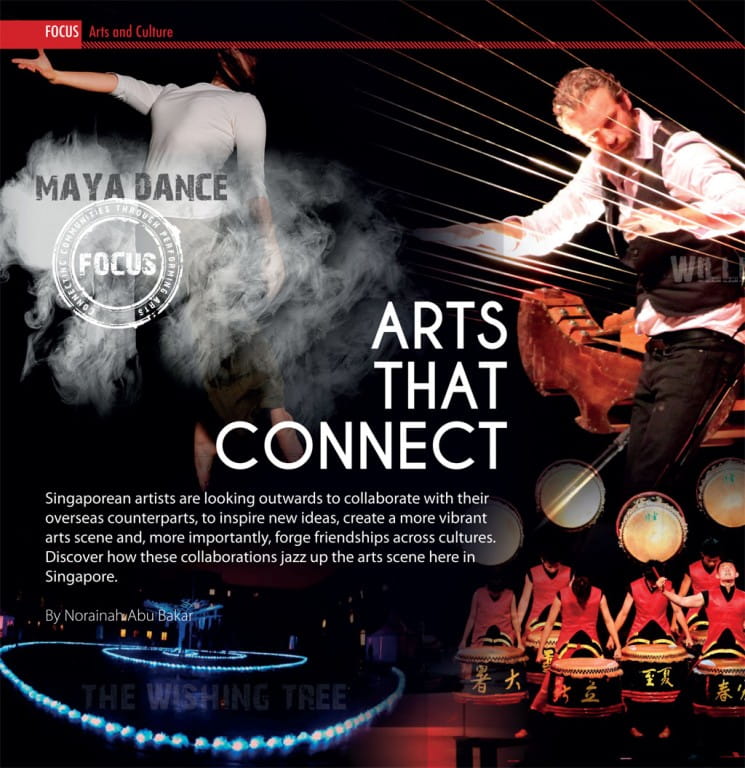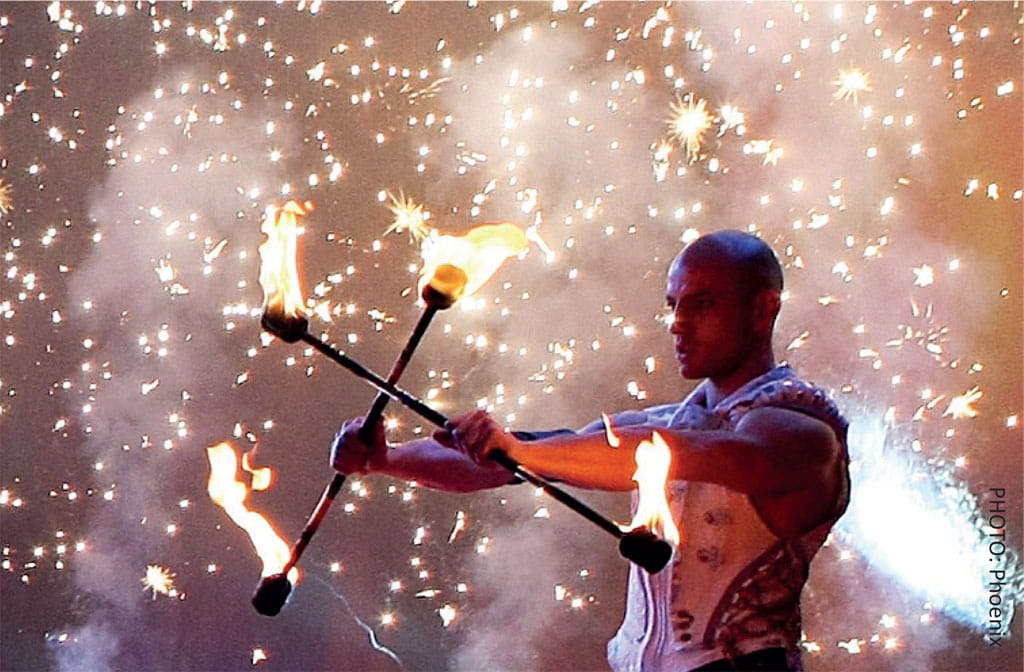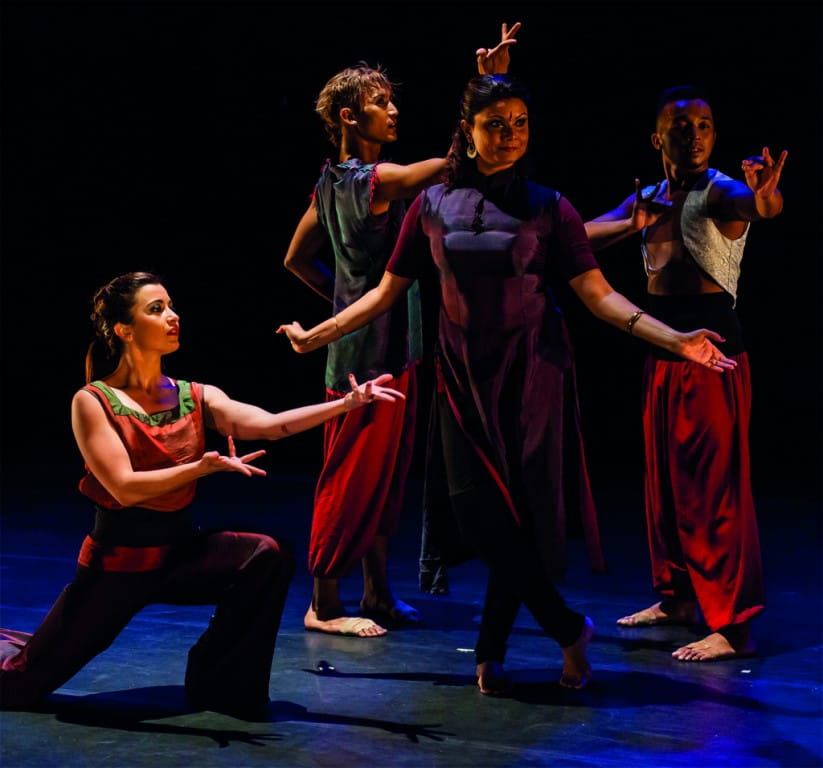
Apicture speaks a thousand words. But the power of art goes beyond just conveying a message. It connects, binds, and builds understanding across cultures and communities. More Singaporean artists are now crossing borders with their craft, collaborating with their overseas counterparts to create unique performances, artworks and new experiences. In the process, they forge friendships and put Singapore on the world map.
UNITING OVER A COMMON IDEA
Jacquelyn Soo believes that working in new environments is a good way for artists to be constantly inspired. The performance artist and founder, curator and chairperson of Singapore Contemporary Young Artists has worked and performed in New York City, Malaysia and Finland, to name a few places, as well as collaborated with international counterparts from Indonesia and the US.
Soo found common ground with US musician Phinestro Robert to create art that transcends language and culture barriers. A notable performance piece is Run Coney Run, which explores running as a bodily experience to distort state, geography and attachment to the physical experience.
In addition to her work with Robert, Soo has also collaborated with Iwan Wijono, an Indonesian performance artist, for a show held in Yogjakarta ,Indonesia, in 2013. Soo’s piece, Recalling Universe (Manunggaling Kawulo Gusti) featured both Soo and Iwan in a contemporary ritual of burying themselves in a sand dune formed by the Merapi volcano. The play is a response to losing a sense of dignity, faith and strength resulting from fluctuations of the economic market.
 Soo explains: “The Javanese way of life is attached to mythology and spiritualism. This belief is so significant to the Javanese. They are full of humility, show compassion and sensitivity to human beings, animals and the natural world.”
Soo explains: “The Javanese way of life is attached to mythology and spiritualism. This belief is so significant to the Javanese. They are full of humility, show compassion and sensitivity to human beings, animals and the natural world.”
Iwan, a long time friend of Soo, shared strong views on being Southeast Asian in an increasingly Westernised society, and both of them were eager to trace their roots through the performance.
“Learning about different languages and cultures made me more down to earth as a person and more compassionate about the diversity of humanity. I am able to forge lasting friendships with some artists because deep inside, we are connected by a common vision, dream, goal and passion,” says Soo.
Soo recounts: “With Iwan, we laughed a lot and everyone had a good time together.” This closeness, brought about by their exchange of cultures, also led to a more informal style of collaboration.
She adds: “At the end of the day, art is a form of beauty, an aesthetic and also a way of thinking. Art is able to cross many barriers and downplay differences. It does not impose or create rules and regulations to define how people should live, work and behave in daily life.”
“Learning about different languages and cultures made me more down to earth as a person and more compassionate about the diversity of humanity. I am able to forge lasting friendships with some artists because deep inside, we are connected by a common vision, dream, goal and passion.”
— Performance artist Jacquelyn Soo
FUSING EAST WITH WEST
The Singapore Night Festival has been one of the highlights in the country’s arts scene for the past six years, boasting a wide array of exhibitions, installations and performances.
One of this year’s highlights was a unique musical collaboration between William Close, a finalist in talent reality show series America’s Got Talent, and local drum ensemble ZingO Festival Drum Group.
Close found fame on the reality show as a musician performing with his own invention, the Earth Harp, considered the world’s largest string instrument. It has strings that stretch to 300m in length and creates cello-like tones and melodies.
ZingO, meanwhile, fuses Chinese drums with martial arts choreography, theatre and Chinese calligraphy, culminating in a unique experience. This tie-up with the American artist was a first for the troupe, challenging its members to operate outside their comfort zone, explains ZingO’s founder and director, Roch Ong Chee Hau.

Jacquelyn Soo in a traditional Balinese costume performing “Recalling Universe” on Parangtritis beach in Yogjakarta.
“When our performances complement each other, there is synergy once mutual respect is established. And that is followed by a stronger friendship.”
— ZingO’s Roch Ong Chee Hau on collaborating with American artistWilliam Close.
The different musical styles of the Earth Harp’s gentle tones and the drums’ vibrant beats also proved to be a challenge, performance-wise. While Ong and his drum group usually go through several rehearsals to prepare for a performance, Close, on the other hand, prefers improvising in-situ during the performance.
“William embraces mistakes and uncertainty boldly,” Ong explained. “For me, I like to consider in advance what can and cannot be done.”
He added, “We worked that out in the end by taking the lead in terms of the tempo of music, since William was able to improvise. We also chose pieces that have more repetitive parts. That allowed him to improvise easily.”
In fact, ZingO was even able to take its collaboration a step further. Says Ong: “We thought it would be nice if William could play something with a local flavour since he was in Singapore. We proposed Dayung Sampan, Rasa Sayang and Di Tanjung Katong, and explained that they are popular Malay Folk Songs that even non-Malays enjoy. We also told him that the National Day song Home is an all-time favourite patriotic anthem for Singaporeans and everyone loves singing it. These were songs William loved to explore.”
Not only did Close explore new local songs to add to his repertoire, he also learnt the cultural significances behind some of Singapore’s well-loved classics.
GAINING NEW INSIGHTS
Ong also recalls a collaboration with a Japanese drumming group in which he learnt about peer respect towards their seniors. Ong comments, “The Japanese showed a very deep level of respect to their elders. Their greetings to their teacher would start with a “kowtow” (deep bow), which sets the tone for the rest of the training session. You know it is not fear but a very rooted behaviour of respect.
His troupe members were able to share their insights of Singaporean culture with their foreign counterparts. “This exchange of culture goes both ways.”
Ong believes that these moments of cultural exchange help to strengthen ZingO’s uniqueness and cultural identity.
“When our performances complement each other there is synergy once mutual respect is established. And that is followed by a stronger friendship.
“The response from the audience was great. The performance allows audiences to get a feel of both Eastern and Western music styles coming together to create something unexpected and magical.”

“Some audience members even mentioned that they could not see the difference between dancers from ODC (USA) and Maya Dance and, at that moment, we felt honoured and we were very happy that we made Singapore proud.”
— Kavita of Maya Dance Theatre.
ART FOR ALL
Global artistic collaborations have not only brought like-minded practitioners together, but also introduced their different cultures to one another. This is the case with Maya Dance Theatre, which worked with foreign counterparts to stage performances in Indonesia, the US and Malaysia.
Kavitha Krishnan, the troupe’s Creative Director and Choreographer, recalled how the dance company tried to convince famed US dance company ODC Dance to team up with them after the two companies met at the Bangkok Fringe Festival in 2010.
After a two-year discussion, ODC finally agreed to collaborate with Maya for both the Singapore Dance Festival, as well as the Walking Distance Festival in San Francisco, which celebrates contemporary dance in the US
and abroad.
Kavita said that the company’s efforts paid off — the collaboration established Maya Dance as a key player in Singapore’s dance scene.
“When we performed in San Francisco, we learnt from the locals and patrons of ODC that it’s artistic director Brenda Way had not collaborated with any party before as she doesn’t like to compromise her company’s performance standards.
Yet, in this instance, she gave us an opportunity to collaborate. Some audience members even mentioned that they could not notice any difference between dancers from ODC and Maya Dance. At that moment, we felt honoured and happy that we made Singapore proud.” Established in 2006, the dance troupe found that working with their counterparts overseas can also inspire local artistes to perfect their craft, gain new skills and new understanding.
And through these collaborations, Maya also gained a new member.
After working with Australia’s premier youth dance company QL2, one of their members, Sheridan Smith, joined the Singapore dance troupe in 2011. For Smith, coming into a new environment and culture meant she had to overcome several obstacles; one example is adapting to Maya Dance’s contemporary Asian style, which incorporates both Javanese and Indian traditions.
The troupe’s General Manager Imran Manaff explains: “Sheridan had no Asian dance background, so she had to learn everything that we were doing. In Asian dance, you don’t wear footwear, so Sheridan learned to incorporate that into her dance style.”
Apart from sharing the Asian dance form with foreign collaborators, Maya Dance also helps to introduce Singapore culture to people in other countries.
Imran elaborates: “We explained to them about the different races we have in Singapore, our cultures, our lifestyles and also how, despite the differences, we are all Singaporeans.”
Art collaborations with overseas counterparts have the power to break down language barriers, merge cultures and even bring in new experiences for local artistes. Most importantly, these fusions of styles, instruments and ideas bring about a global awareness of Singapore’s art scene, and bring the country’s talent and prowess to a global audience.
Manaff summed it up best. “The world is not Singapore nor is Singapore the world. How else are artistes supposed to bring their art out if they do not perform or travel overseas? Singaporean artistes should go out to perform; to see the world and to show what Singapore has to offer the world.”

Maya Dance Theatre artistes gain a deeper understanding of the arts and culture by collaborating with their foreign counterparts.
